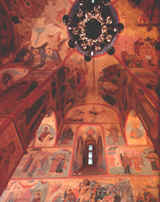|
|
The slender single-domed Church of the Deposition of the Robe stands on Cathedral Square between the Cathedral of the Assumption and the Facets Palace. It used to be a domestic church of Russian metropolitans, but after 1589, when the institute of the Patriarchate was introduced to Russia, it became a church of Russian patriarchs. In olden days it was linked to their personal apartments by several passages. Like all other Kremlin churches the Church of the Deposition was built on the site of an older church of the same name. It is recorded that in 1450 “Metropolitan Jonah laid the foundation stone of the Church of the Deposition of the Virgin’s Robe”. During the big fire of 1473, the first Church of the Deposition was burnt down together with the metropolitan’s quarters. The new church which was founded on the same site has survived to the present day.
This new Church of the Deposition was built by Psckov masons in 1484-1485. It was devoted to a festival which was first celebrated in Byzantium in the 5th century when, according to the legend, a major relic-the Virgin’s robe (or dress)- was brought to Constantinople from Palestine. In Rus, this robe was believed to be sacred and miraculous and to have the power to protect the city from enemies.
The church stands on an elevated base and is a typical example of Moscow architecture even though Pskov-style features can be found on the building’s facades. The slim pilasters which divide the facades vertically, along with the decorative arches on the apses (semi-circular altar projections), careen-shaped white-stone portals, the gables, and the helmet-shaped gilded cupola on a slender drum-all give the church lightness, elegance and smartness.
The small and intimate interior fully suits the purpose of the church. It is decorated with frescoes in 1644 by the artists Sidor Pospeyev, Ivan Borisov and Semyon Abramov. The themes of the frescoes are devoted to the Virgin. On the walls there is “The Akathistos” which glorifies the Virgin as the patroness of all people interceding with God for them, and also “The Life of the Virgin” showing her childhood, youth and death after which she became THE “Tsarina of the Heavens”. The fresco on the south wall shows how Constantinople was miraculously saved from the enemy siege when the patriarch dipped the Virgin’s Robe into the waters of the bay. The small size of the church predetermined the composition of frescoes, which look like small icons. Frescoes are painted along the entire perimeter of the walls divided horizontally into five tires. At the bottom, the artists painted white draperies adorned with ornamental patterns.
Frescoes on the pillars of the church are also noteworthy: on the south pillar the artists depicted the Moscow tsar’s family tree, and on the north one they portrayed Moscow metropolitans, predecessors of the Russian patriarchs.
Frescoes in the patriarch’s church glorify the power of the church and its close alliance with the power of the Moscow grand prince under the protection of the Virgin.
The iconostasis of the church beautifully matches the colorful frescoes. The work of one of the best icon-painters of the first half of the 17th century Nazary Istomin-Savin, it was painted in 1627 and impresses one by its high level of workmanship. The artist’s drawing is calligraphically precise and truly virtuoso. The generally soft color scheme produces a festive effect, which is largely due to the use of pure red and white colors. This impression is enhanced by the gilded icon-frames.
The lower, local tier of the iconostasis contains icons of the 16th-17th centuries. The main icons of the church are traditionally placed on both sides of the Tsar’s Doors to the altar. Among them are: the 17th-century icon “The Deposition of the Virgin’s Robe”, the 16th-century icon “The Virgin of Tikhvin” with border scenes painted in the 17th century, “The Trinity” by Nazary Istomin, and also the icon of the Virgin portrayed full-length in the 17th century.
The iconostasis and the fresco paintings from a single composition, which harmoniously balances the architecture.
In the mid-17th century, in connection with the construction of a new domestic church for Patriarch Nikon, the Church of the Deposition of the Robe was attached to the Tsar’s Palace and linked to it by roofed passages.
Nowadays, the north gallery of the church houses a Small wood sculpture exhibition of the 15th – 17th centuries. Displayed here are big carved icons and small folded icons, which were usually used on journeys. These works would have come from Old Russian woodcarving centers such as Novgorod and Rostov Veliky and from Russia’s North. Such works as the sculpture of Moscow Metropolitan Jonah executed for his tomb which is in the Cathedral of the Assumption, or the monumental sculpture of Saint George of the late 14th- early 15th centuries, are proof of the high level of wood-carving. The 17th-century sculpture of St. Nicholas of Mozhaisk holding in his left hand a model of the city, and in his right hand a sword, is also most remarkable. In old times this sculpture used to decorate the gates of the Russian town of Mozhaisk.
Old Russian wooden sculpture displays distinct features of original folk art. Regrettably, very few works of this kind have survived, which makes the prospect of seeing them in one of the best architectural monuments of the Moscow Kremlin even more attractive.

|
|

